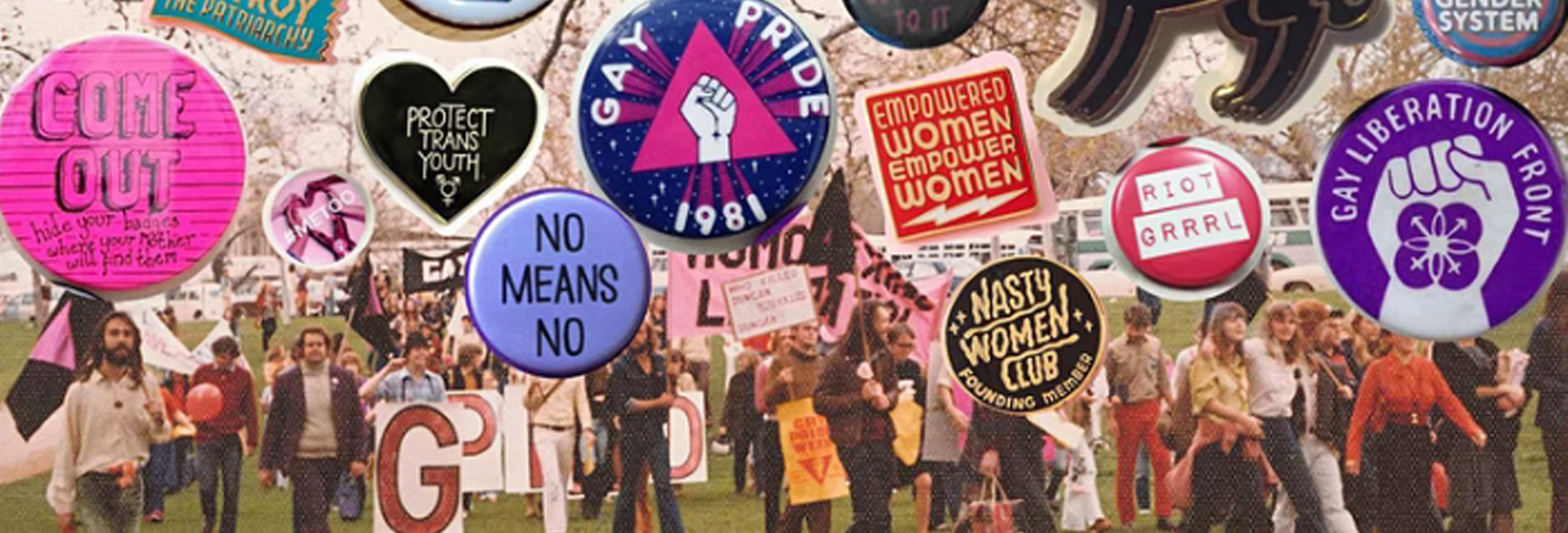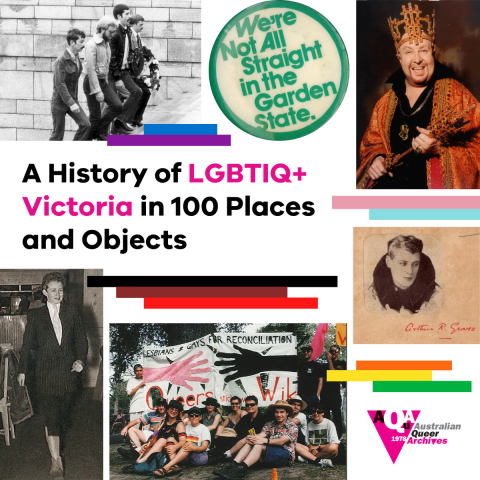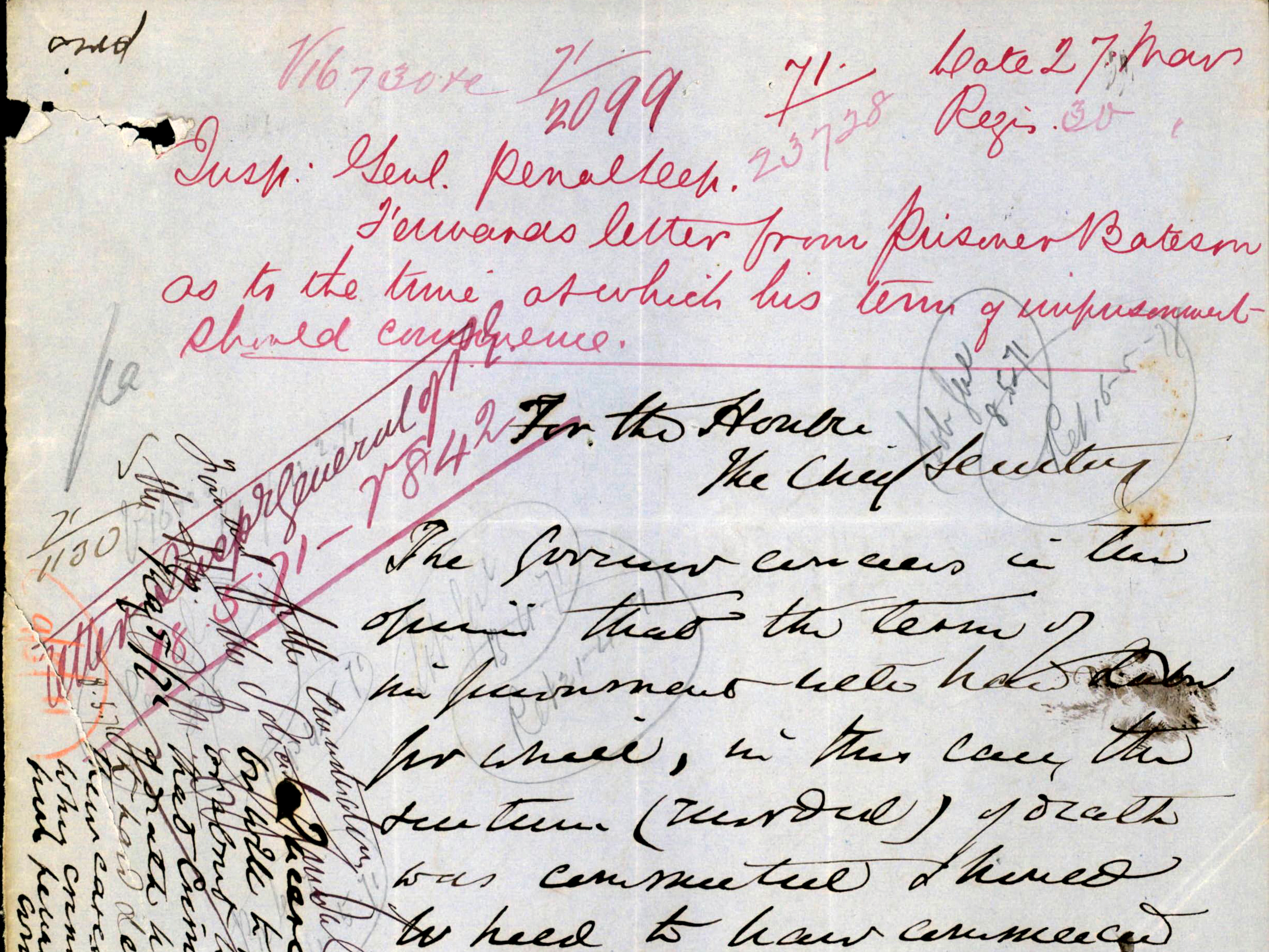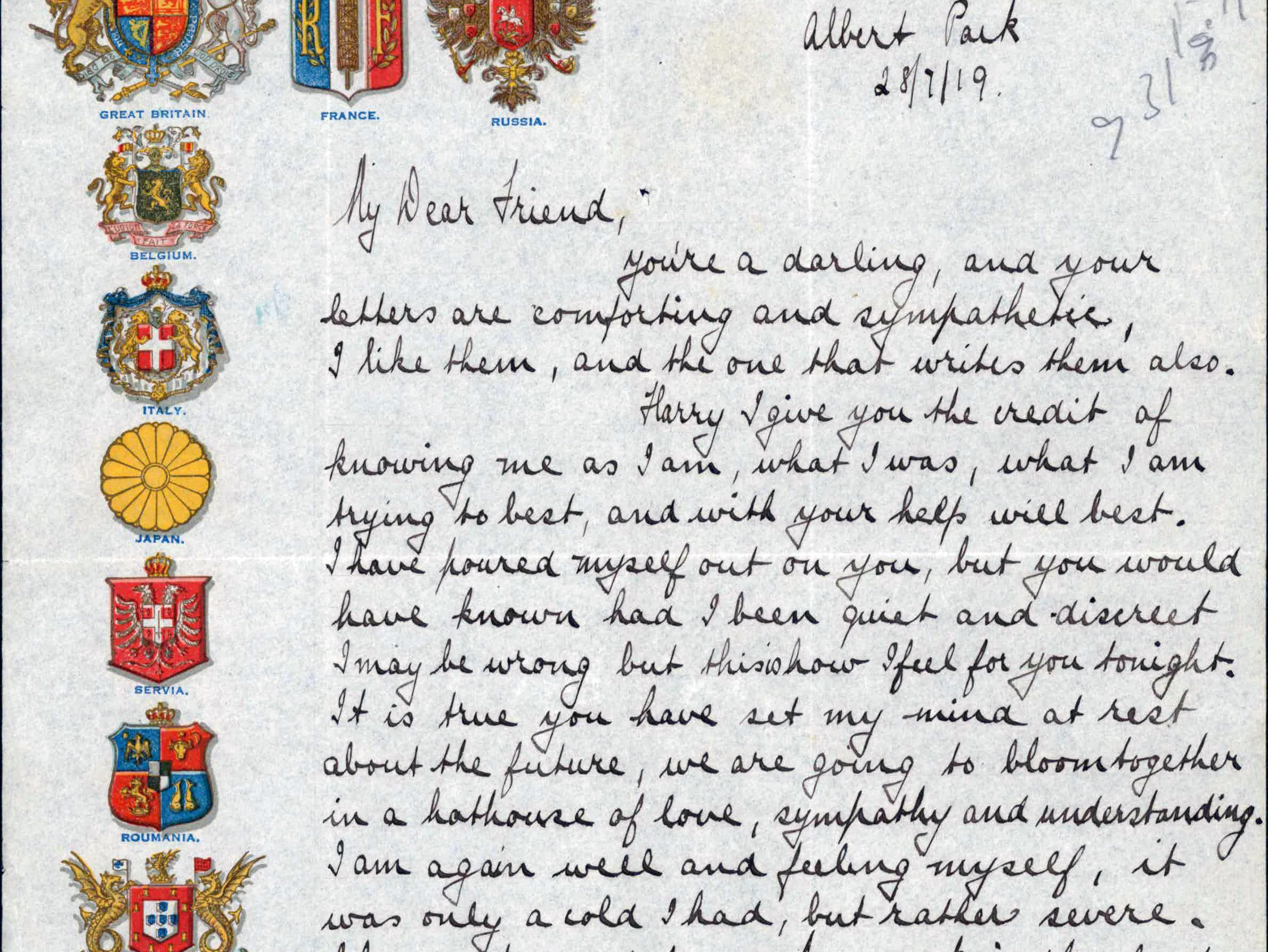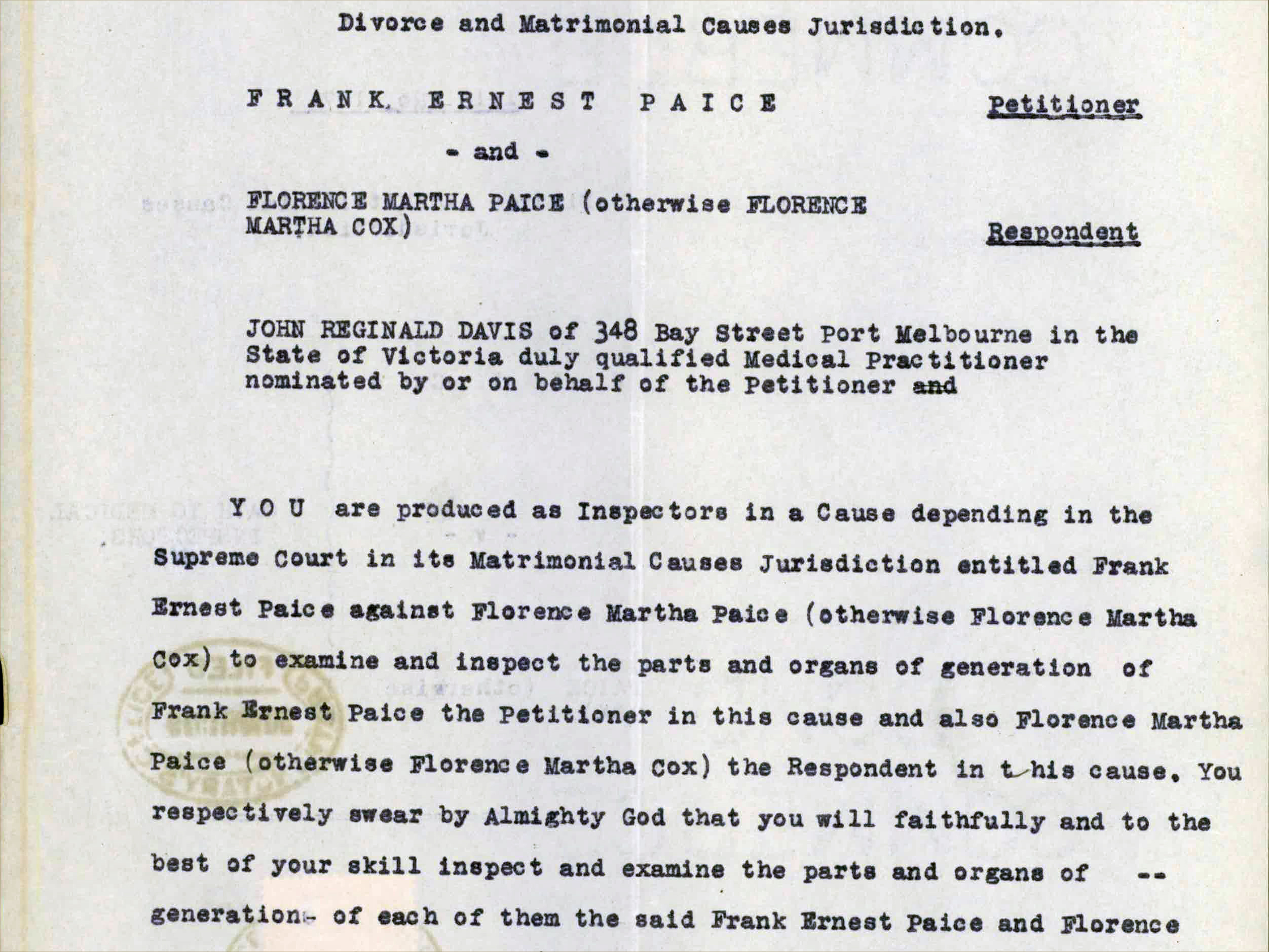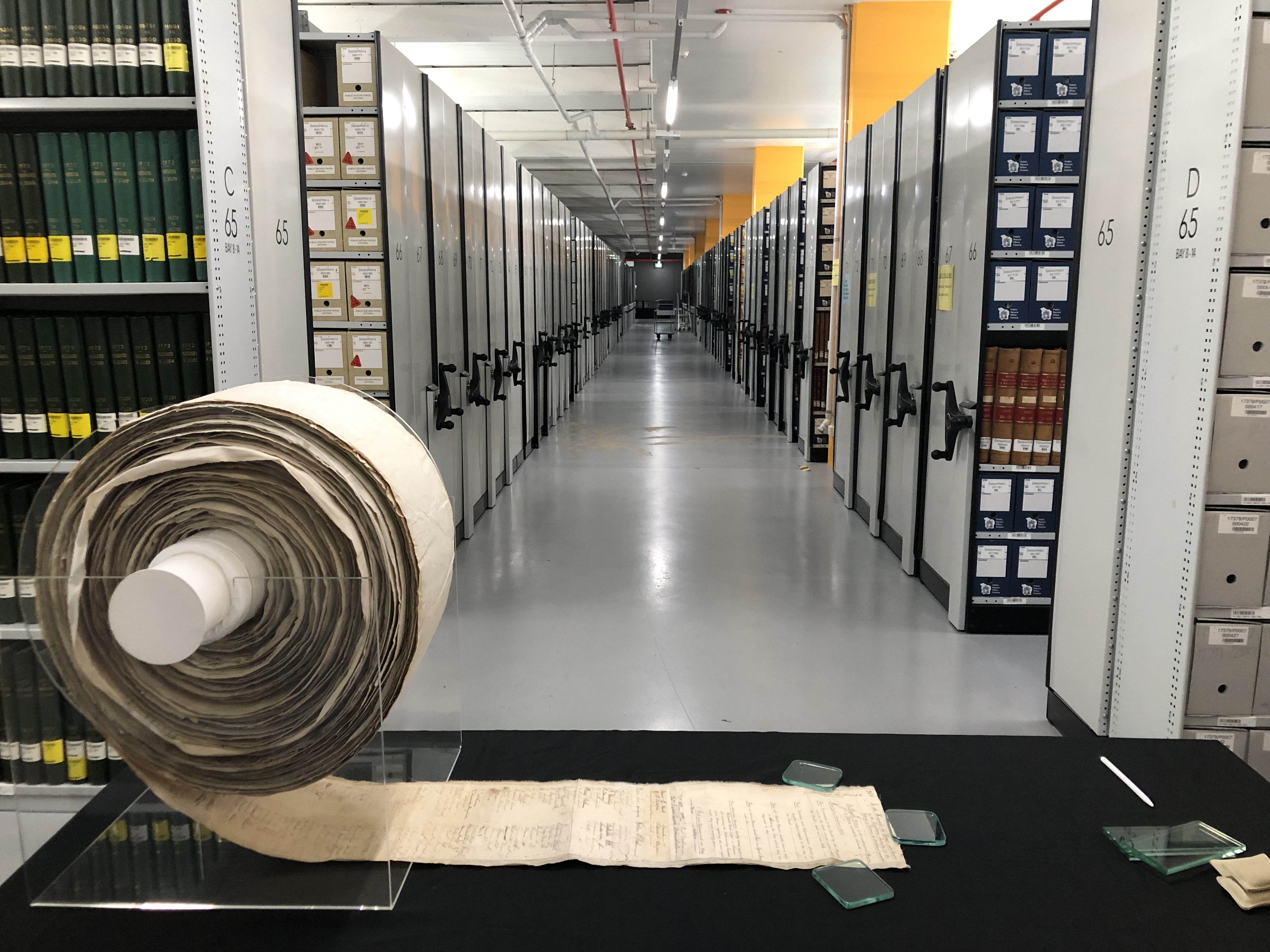From the podcast series ‘Look history in the eye’
Written and presented by Angela Bailey
Produced by Public Record Office Victoria
Music by Jack Palmer
(Warning to listeners/readers this podcast and transcript includes historical terminology, found in the records, that is offensive today.)
Transcript
Kate Follington
When Graham Willet, Wayne Murdoch and John Moore, put on their glasses and folded back the fragile pages of archived handwritten records preserved for over a century and held at the Victorian Archives Centre, they uncovered significant queer history dating back to 1861.
Angela Bailey
He originally was sentenced to death, but this was pardoned down to 15, 16 years in Pentridge with the first four years spent in irons.
Kate Follington
That’s Angela Bailey talking about the conviction of George Bateson who you’re going to hear more about in today’s episode. My name’s Kate Follington and you’re listing to the podcast Look History in the Eye, produced by Public Record Office, the archive of the State Government of Victoria. 100 kms of public records about Victoria’s past are carefully preserved in climate controlled vaults. We meet the people who dig into those boxes, look history in the eye, and bother to wonder why.
You can always download the records that help tell these stories by searching Look History in the Eye podcast online.
Today’s episode is a recording of a presentation made for International Archives Day at the Victorian Archives Centre in 2022. It’s about a groundbreaking report released recently called a History of LGBTIQ+ Victoria in 100 Places and Objects produced by Heritage Victoria and the Australian Queer Archives. Interestingly it includes 5 archives from the public collection. Including the first known record of an intersex person, records about inner city gay beats, and charges of homosexuality during the colonial period.
Co author Angela Bailey is the Vice President of the Australian Queer Archives at the Pride Centre in St Kilda and she started by explaining a little bit more about how the queer archive began.
Angela Bailey
It started in 1978 after a dedicated group of activists at the time who were involved in gay liberation saw the need to collect the material that was being produced at that time. Because essentially no one else was really collecting it and they really saw the need to start doing that. So they started collecting mainly paper based material and then went on of course to collect a lot of the other items from that time, badges, tshirts, and that was the starting point of the collection. We have about 600 shelf meters of material and one of the things that we did during covid, was produce this report which I’m going to talk to today which is A History of LGBTIQ+ Victoria in 100 Places and Objects. Sneakily there’s actually 101 entries in there but no one seems to have picked that up. Just to queer it up a bit and we find that ourselves a lot in the history walks that we do that it really does appeal to a broader community not just the queer communities in terms of learning some of that history because the major cultural institutions have been playing catch up in terms of collecting material from the LGBTIQ communities.
So where we started from in terms of our community consultation was at Midsumma carnival. We had a stall there that we always do every year, but this time we had a few maps and sticky notes out and people just started to add little places and things that were significant to them. Bars and clubs, saunas, beats, and that was where we started from building up this idea of 100 places and objects. Because of the nature of Heritage Victoria and their reporting it had to be places and objects, it couldn’t be people. But through the entries in the report we tried to weave as many people and events into the story that we could through those places and objects.
Much of the evidence for same sex activity in Melbourne in the early 20th century comes from court cases and sensationalist news reports with their eye witness accounts of the use of local beats these documents in the collection of the Public Record Office Victoria provide a more detailed understated account making them some of the more unusual and historically significant records in Melbourne’s queer history. They also feature of course many instances of betrayal and entrapment in terms of the stories. We’ve got to remember that these records of their time were sometimes very traumatic experience for these participants who would have feared and lived discrimination, violence, conviction and incarceration.
When the British arrived in Australia in 1788, they brought with them their laws. One of them dating back to the time of Kin Henry the 8th being the crime of buggery an offence punishable by death. This was still the law in Victoria when Victoria separated from NSW in 1851. Over the course of the 19th and 20th centuries, the penalties were reduced but the scope of the laws expanded to cover acts such as gross indecency between men 1919, and loitering for immoral purposes 1961. In 1966 this was changed to loitering for homosexual purposes. Despite these laws, homosexual men went on finding ways to meet. Cafes, parties, in parks and on the streets and in the laneways of the city. There were house parties, weekends away, fancy dress balls, there were even same sex marriages. It was never against the law for women to have sexual relations with each other although the British parliament came close to criminalising it in 1921. But lesbians were subject to discrimination, persecution and, like homosexual men, lived their lives mostly avoiding public attention.
Beginning in the 1960s, demand for reform started to be heard for the decriminalisation of sex between consenting adults in private, and then for anti-discrimination laws, relationship recognition, the protection of families headed up by same sex couples and then eventually same sex marriage. And then in 2016 a law passed by the Victorian State Government for the expungement of those convictions that gay men had against their name.
So moving on to one of the first PROV items is the letters of George Bateson. The record itself is a remarkable cache of letters written by George Bateson who was arrested and convicted of sodomy in late 1860s. there are some 200 letters addressed to notable Victorians including the Governor, Premier, Inspector General, lawyers, members of Parliaments, by George Bateson all requesting his conviction to be squashed. He originally was sentenced to death but this was pardoned down to 15, 16 years in Pentridge with the first four years spent in irons. It was basically entrapment that ended up putting George Bateson in Pentridge. On the night of the Friday 16th of November 1860, livestock dealer by the name of George Bateson was in bed with a young ship’s carpenter William Gardner at a local Melbourne hotel. They had met in Bourke Street one night and had already spent a night together. After that first night together, William Gardner went and reported it to the police, and the police said to him “Go back to George Bateson again the following night, we’ll be nearby, when you give us the signal, we’ll come in and arrest him.” So two detectives hiding in a closet next to the room, burst in and arrested both men. The police has, as I said, mentioned to Gardner to give them the signal, and there was two coughs and then they burst in. This is the earliest known Victorian example of police entrapment for a homosexual offence.
Entrapment at that time was unusual. The Chief Commissioner of Police strongly disapproved. Bateson was convicted of sodomy on the events of Gardner and the police. His death sentence was commuted to 15 years hard labour, the first four in irons. He was eventually released just shy of, I think, four years earlier than his original sentence and he was released in 1871. And like I said he never stopped trying to clear his name.
These letters are a fantastic record because they do tell that story of entrapment but they also tell the story of a man trying to clear his name because he also suggests in a lot of his letters that this conviction is outrageous for the crime that he was said to have done. There’s a lot of anguish in his letters and he keeps writing them right up to 1871 and he’s already spent 11 years in Pentridge. He apparently died in Naples in 1879. In terms of the expungement of his conviction, it’s only available as such if a family member applies to have that family member’s conviction quashed. So we never really know what happened to George Bateson.
This is the next story. The detail that Mr Cleale’s letters went into enabled us to almost recreate a beats map of Melbourne from the early 1900s. Effeminate young men using various conveniences for an evil of the most terrible description. He goes on to describe the detail of how these beats work. One cannot enter but two or three of the above fellows rush in and on pretence of using same will pass some disgusting remark concerning ones person. The Chief Commissioner after this letter dispatched one of his officers to investigate. Sergeant Canty report provides further detail and descriptions of who he encountered at the public toilets. He reported that the men known by the term ‘pufters’ are generally well dressed, sober, quiet in their manner, and some of them are very well connected to some of the families of Melbourne. Canty further noticed about these men:
“… it is often very difficult for the police to catch them offending, and if they do at any time make filthy or indecent overtures to any man, they believe him to be similarly inclined, but should they make a mistake the man insulted never thinks of giving any of them in charge, but sometimes gives the offender a well-deserved blow or kick instead...”
One of the interesting things about this letter is the sting in the tail by the Police Commissioner at the time that he believes that Mr Cleale’s letter was very much exaggerated. While he acknowledges what was going on, he does make the point, at the end of his report, that it was particularly interesting that Mr Cleale made such interest in being so interested in what was going on at these beats.
I just wanted to segue way a little bit for a minute and talk you through a little story that does relate to beats, but more so in a much more different setting. 1960s. Another form of entrapment. This is the story of Peter McEwan who at the age of 17 in Dendy Street Beach in Brighton, was arrested, charged and convicted of a homosexual offence. The stigma of this event of course held a long lasting resonance with Peter. Peter was one of the…and that’s his photo a little protest, one of the first gay protests in Melbourne, 1972 in the old city square. It’s a photo by Peter who was very much involved in gay lib, he was one of the original board members of the Victorian Pride Centre and I’ll just read you a little bit about his experience from that time. So there was a lot of entrapment happening at some of those beats along the foreshore, in some of our early records of phone help lines there’s a lot of people ringing up and explaining what’s happening to them in terms of being convicted. The other photo shows one of, it’s Graham Carbri on the far left holding up a banner complaining protesting about this entrapment of the beats down on the beach area. So this is the words of Peter:
“The experience was extremely traumatic and to this day I feel a great sense of unfairness about what happened to me. The shame and stigma that accompanies a criminal conviction is deeply corrosive. I visited the beach in Brighton that day, a beach known to be frequented by gay men. I was extremely naïve, I was 17 and driven by hormones and instincts to make contact with gay men. I was in some bushes hidden from public view with a 22 year old man when the police burst in. At the most we were just touching each other. When I was arrested I didn’t know what on earth was going on. The police didn’t advise me of my rights and I wasn’t given the opportunity to call my parents. I was told it would be best for me if I signed a statement the police had written. Even when I was finally represented by a lawyer it was too late, I pleaded guilty and was convicted of a homosexual offence and released on a two year good behaviour bond. The court ordered psychiatric report said I was gay but sexually immature. I think that is what saved me from a custodial sentence. Looking back I did take on the guilt and shame. It was like holding a terrible secret. I fled overseas to escape and removed myself from family for a number of years until I found a way to accept myself with pride.”
Peter was in the public gallery of the Victorian State Parliament in 2014 when the historical homosexual convictions expungement bill was put before the Victorian Parliament and (?) acknowledged his story.
The next little story I have here is a cache of twenty love letters between Melbourne men Ben Morris and Harry Bruin covering a period of several months in 2019 (misspoke, actually 1919). The collection of approximately twenty letters consists of original letters handwritten by Morris and then replies by Bruin. Love letters between men from this period are extremely rare in an Australian context and also globally. These letters still exist today because they were ceased by police from Bruin’s home in Auburn in October 1919. The police were investigating a report that Bruin and Morris were conducting an intimate affair. The relationship came to light when the mother of one of Morris’ friends, having failed in her attempt to blackmail Bruin, went to the police. Blackmail was an ever present danger to homosexual men at the time. Homosexual sex was against the law and even the gossip alone could ruin reputations, careers and social standings. In refusing the demands of his attempted blackmailer, Bruin took an enormous risk. However Morris and Bruin were lucky that their letters contained no descriptions of sex acts and in a lot of the letters you’ll see it’s very much a friendship. It’s always referencing a friendship. It was not illegal to express love for a person of the same sex and when the matter came before the court the police had no choice but to drop the matter without laying charges. These letters are also important because, together with the statements taken from the two men and others involved in the case, the provide insight into the development of a liaison over extended period. The emotional letters provide rare evidence of a deep romantic affection between two men in their own words.
Yeah so you don’t often find letters like this from that time. I remember also hearing a story of a bit later in the fifties. It was two men in a relationship in London and they lived in a little flat in Brixton, they were together for forty years and every day one of the men documented their lives, their domestic lives, in a little diary. But the diary was only this big, tiny little thing so it could easily be hidden, just in case they were ever in a situation where they might face harassment by police. So it’s interesting that that’s an attempt to try and secure their story and save it, but they knew that they had to be careful and that’s why so many of this type of material did disappear.
This is the next item that we feature in the heritage 100 report and this story always makes me feel a little bit uncomfortable but I feel more comfortable knowing that I’m telling the story that one of the relatives of Florence Cox tried to bring to light. And he went to a lot of detail, effort, to try and bring her files out to find out about her. Because the story itself is one of the first stories of an intersex person in Victoria. The file previously held in the Supreme Court of Victoria is now held in the Public Record Office. It contains records of the annulment of the marriage of Florence Cox in 1919 as the earliest known record of a person with intersex variations in Victoria’s history. This is of very unique historical significance in terms of LGBTIQ history. Florence Cox born in 1887 had a middle class upbringing in Melbourne. In 1914 she travelled to Bengal to marry her fiancé Frank Paice and to join him in his ministry work for the Baptist Church. The couple returned to Melbourne in 1918 and in the following year the Supreme Court of Victoria, at Paice’s request, annulled their marriage based on being unable to consummate marriage due to a “malformation frigidity or other defect of the parts of the other person.” So you can see that this is, it would have been incredibly traumatic for the other person in this relationship and these records also show the intensity of medical examinations and in the end that incredible trauma mentally to Florence Cox. So, in 1997, Cox’s great grand nephew, Ian Richardson set out to investigate the secrecy surrounding his great aunt Florry. Following a relentless two year campaign by Richardson and other descendants of Cox and Paice, the Supreme Court file was finally opened to the public. Richardson’s book God’s Triangle recounts his quest and brings Cox’s story out of the archives and into the light.
So this is a story, there are quite a few stories in the collections. There’s notable ones in the State Library collection, but also in this collection in terms of that medical scrutiny of someone in relation to their sex.
Then one of the other entries in the report references the Women’s, a lot of you would know this story, the Women’s Suffrage Petition. So we also have in there the reference also to the sculpture, the great petition artwork, down at the back of Parliament House. So the sculpture itself is a 20m steel and blue stone sculpture designed by Susan Hewitt and Penelope Lee located near state Parliament. It celebrates the 1891 women’s suffrage petition and the hard fought struggle for women’s right to vote in Victoria. The original petition contains some 30,000 signatures and was dubbed the monster petition and is now held at PROV. The Victorian women’s right to vote was won in 1908 and the sculpture was unveiled in 2008 to mark this centenary. The women’s suffrage movement in Victoria was joined by many women over decades and transformed the lives of those involved, often profoundly. Same sex attracted women played an important role in the suffrage campaign and the independence they won was a significant precursor to second wave feminism and the lesbian movements of the 1970s. One of the signatories of the petition, which was memorialised by the sculpture, was Mary Fullerton. She was born in 1868 in Gippsland and published her first book of sonnets in her early twenties. She was active in the women’s rights movement, advocating for the vote, marriage and divorce equality and inheritance rights. In 1910 while campaigning to our prominent feminist and suffragette Vid Goldstein elected to the state Parliament, Fullerton met Mabel Singleton. They soon became friends and the relationship grew more intimate. They lived together raising Singleton’s son from 1922 until Fullerton’s death in 1946. Between 1910 and 1922, Fullerton wrote some hundred poems reflecting on the relationship and her love for Singleton who she described as the beloved immediate friend the chosen of my heart. They are expressions of profound physical and emotional attachment. The 1891 petition and its sculpture reflect the stories of thousands of Victorians who supported women’s right to vote and the passions between women that also signed that petition. There’s a great book by Sylvia Martin Passionate Friends about Mary and Mabel’s life. What I love about that petition is that you can just go on and check out everyones names, and I remember when that sculpture was launched they talked about also how women would hold little parties so that’s why you often find the same address in the petition because they’re all at a little petition party. And often a lot of the women didn’t use their married name, they used their maiden name, in signing it as well, so you can often find relatives in there that did sign that petition.
So that’s our five PROV items that we featured in the report. So what this report also does is that it talks to some of the places that the community created to find that was safe and safe bars and clubs and the people that created those spaces. And one of my great stories is Val Eastwood, this is her in her pinstripe suit, entourage in her café in Val’s café in Swanston Street and Val created a really safe place for queer people of the fifties to meet. It was also a really popular place for members of the theatrical community who’d come there, Val often would be the cook in the kitchen. There was a piano, people would get in there and people would do a few tunes. Sometimes, depending on what was happening in the city they’d put a lookout downstairs just to keep an eye on people who might try and come in who weren’t the right clientele or if there was police. So she really did create a haven. Val’s café was referenced in our report, it I think still exists as Hare Krishna restaurant in Swanston Street.
And there was many other examples so Jan Hillier again created a lot of bars and clubs and places that were safe for people to meet off the streets. So safe places off the streets for queer people to meet. And again Jan also, in the Australian Queer Archives we have about 600 oral histories and in the one with Jan she does talk about being in a bar and being one of the lookouts in the front part of the bar, because in the back part of the bar was the meeting place for a lot of the women who were in the military police and so someone had to always be on the lookout at the front in case someone came looking for them knowing that they might be there because they’d lose their jobs.
So there’s really some of those rich stories is what we tried to put through the report in terms of how people in the community stepped up and tried to make safe places. And I think that’s what this presentation and what this report talks to, is that people stood up against discrimination and violence and I think those stories are what we tried to capture in this heritage 100 report.
